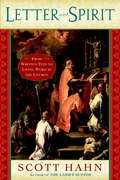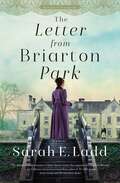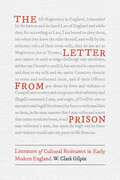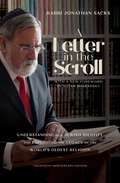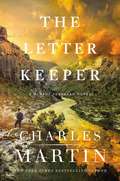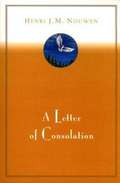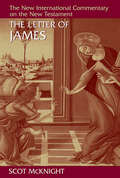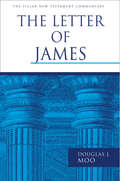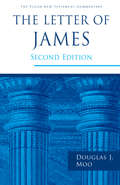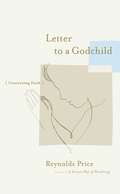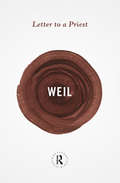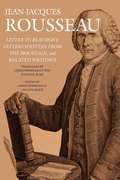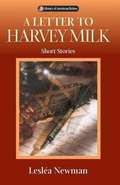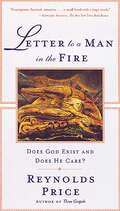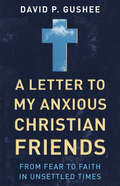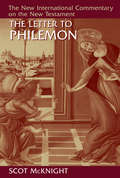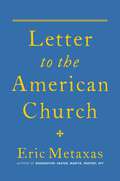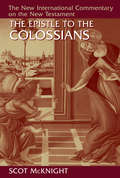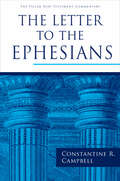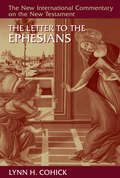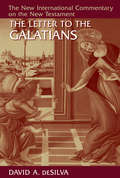- Table View
- List View
Letter and Spirit: From Written Text to Living Word in the Liturgy
by Scott HahnA publication of the St. Paul Center for Biblical Theology in Steubenville, Ohio, "Letter & Spirit" is a new journal of Catholic biblical theology which seeks to foster a deeper conversation about the Bible. In light of the advancements of the last century in recapturing the historical and literary context of Scripture, "Letter & Spirit" embraces the challenge of the next century--linking the scientific study of Scripture to its liturgical sense in the Church's living tradition.
Letter from Birmingham Jail
by Martin Luther King Jr.During the struggle for civil rights in the 1960s, Martin Luther King emerged as the movement's most eloquent leader. The two selections here testify to the emotional and logical power of his arguments. In "Letter from Birmingham Jail," King explains why blacks can no longer be prisoners of inequality. His "I Have a Dream" speech, delivered to 250,000 civil rights marchers in 1963, is another moving appeal for equality.
The Letter from Briarton Park (The Houses of Yorkshire Series #1)
by Sarah E. LaddIn Regency England, one letter will alter a young woman&’s fate when it summons her to Briarton Park—an ancient place that holds the secrets of her past and the keys to her future.Cassandra Hale grew up knowing little about her parentage, and she had made peace with the fact that she never would. But Cassandra&’s world shifts when a shocking deathbed confession reveals a two-year-old letter from Mr. Clark, the master of Briarton Park, with hints to her family&’s identity. Stung by betrayal, she travels to the village of Anston only to learn Mr. Clark has since passed away.James Warrington is a widower and the new master of Briarton Park, where he lives with his two young daughters, his sister, and his mother-in-law. When Cassandra appears at his doorstep with a letter from the previous owner and then proceeds to assist his family in an unexpected way, he is honor bound to help uncover the answers she seeks.The more time Cassandra spends in Anston, the more she begins to suspect not everything—or everyone—is as they seem. As details emerge, the danger surrounding her intensifies. Using wit and intuition, she must navigate the treacherous landscapes between truth and rumor and between loyalty and deception if she is to uncover the realities of her past and find the place her heart can finally call home.Sarah Ladd&’s latest Regency romance, first in the new Houses of Yorkshire series, combines mystery and intrigue with the best of historical storytelling.Praise for The Letter from Briarton Park:&“The swoon-worthy romance of Jane Austen meets the suspense of Charlotte Bronte in Sarah Ladd's enthralling The Letter from Briarton Park. As Cassandra navigates the mystery of her own life, it is absolutely clear that family—either of blood or heart—are where she, and we, ultimately find our home.&” —Joy Callaway, international bestselling author of The Fifth Avenue Artists Society and The Greenbrier ResortSweet Regency romance with mystery elementsThe first book in the Houses of Yorkshire series, but can be read in any orderBook length: approximately 91,000 wordsIncludes discussion questions for book clubs
The Letter from Prison: Literature of Cultural Resistance in Early Modern England
by W. Clark GilpinLetters from prison testifying to deeply felt ethical principles have a long history, extending from antiquity to the present day. In the early modern era, the rise of printing houses helped turn these letters into a powerful form of political and religious resistance. W. Clark Gilpin’s fascinating book examines how letter writers in England—ranging from archbishops to Quaker women—consolidated the prison letter as a literary form.Drawing from a large collection of printed prison letters written from the reign of Henry VIII to the closing decades of the seventeenth century, Gilpin explores the genre's many facets within evolving contexts of reformation and revolution. The writers of these letters portrayed the prisoner of conscience as a distinct persona and the prison as a place of redemptive suffering where bearing witness had the power to change society.The Letter from Prison features a diverse cast of characters and a literary genre that combines drama and inspiration. It is sure to appeal to those interested in early modern England, prison literature, and cultural forms of resistance.
A Letter in the Scroll: Understanding Our Jewish Identity and Exploring the Legacy of the World's Oldest Religion
by Rabbi Jonathan SacksFor too long, Jews have defined themselves in light of the bad things that have happened to them. And it is true that, many times in the course of history, they have been nearly decimated: when the First and Second Temples were destroyed, when the Jews were expelled from Spain, when Hitler proposed his Final Solution. Astoundingly, the Jewish people have survived catastrophe after catastrophe and remained a thriving and vibrant community. The question Rabbi Jonathan Sacks asks is, quite simply: How? How, in the face of such adversity, has Judaism remained and flourished, making a mark on human history out of all proportion to its numbers? Written originally as a wedding gift to his son and daughter-in-law, A Letter in the Scroll is Rabbi Sacks's personal answer to that question, a testimony to the enduring strength of his religion. Tracing the revolutionary series of philosophical and theological ideas that Judaism created -- from covenant to sabbath to formal education -- and showing us how they remain compellingly relevant in our time, Sacks portrays Jewish identity as an honor as well as a duty. The Ba'al Shem Tov, an eighteenth-century rabbi and founder of the Hasidic movement, famously noted that the Jewish people are like a living Torah scroll, and every individual Jew is a letter within it. If a single letter is damaged or missing or incorrectly drawn, a Torah scroll is considered invalid. So too, in Judaism, each individual is considered a crucial part of the people, without whom the entire religion would suffer. Rabbi Sacks uses this metaphor to make a passionate argument in favor of affiliation and practice in our secular times, and invites us to engage in our dynamic and inclusive tradition. Never has a book more eloquently expressed the joys of being a Jew. This is the story of one man's hope for the future -- a future in which the next generation, his children and ours, will happily embrace the beauty of the world's oldest religion.
The Letter Keeper (A Murphy Shepherd Novel #2)
by Charles MartinCombining heart-wrenching emotion with edge-of-your-seat tension, New York Times bestselling author Charles Martin explores the true power of sacrificial love.Murphy Shepherd has made a career of finding those no one else could—survivors of human trafficking. His life&’s mission is helping others find freedom . . . but then the nightmare strikes too close to home.When his new wife, her daughter, and two other teenage girls are stolen, Murphy is left questioning all he has thought to be true. With more dead ends than leads, he has no idea how to find his loved ones. After everything is stripped away, love is what remains.Hope feels lost, but Murphy is willing to expend his last breath trying to bring them home.Praise for The Letter Keeper:&“A man broken by events beyond his control accepts the challenge to walk dark ways in order to bring the lost and helpless home, but he comes close to losing himself in the process. Despite the hardship and heartache, Martin&’s story shines with the light of eternal hope.&” —Davis Bunn, writing for Christianity Today&“It is unequivocally, hands down, a remarkable read. It&’s everything you want (and a whole lot more) from a sequel . . . Y&’all better get ready. Like I said last time, clear your schedule. Then read this book . . . front to back. There will be more sweaty palms, fist pumps, tears, and laughter than the first one. I promise.&” —Charlie Martin, Charles Martin&’s sonFull-length novelOne of the Murphy Shepherd novels:Book One: The Water KeeperBook Two: The Letter KeeperBook Three: Coming June 2022!Includes discussion questions for book clubsAlso by Charles Martin: The Mountain Between Us, Send Down the Rain, Long Way Gone, When Crickets Cry
A Letter of Consolation: A Combined Edition Of The Nouwen Classics In Memoriam And A Letter Of Consolation
by Henri J. M. NouwenFinding faith in a time of sorrow Beloved author Henri Nouwen reflects on the spiritual significance of death and life in this moving meditation dedicated to "all those who suffer the pain that death can bring and who search for new life."
The Letter of James (The New International Commentary on the New Testament)
by Scot McKnightScot McKnight here explains the Letter of James both in its own context and as it may be seen in light of ancient Judaism, the Graeco-Roman world, and emerging earliest Christianity. From beginning to end, the book is shaped for pastors, teachers, and scholars. McKnight is less interested in shedding new light on James than on providing a commentary for those who want to explain the letter and its significance to congregations and classes. This commentary is accessible to a broad readership, at once full of insight and of good sense and wit that makes for good reading. The Letter of James is an especially helpful source for consultation as to what James is about.
The Letter of James (The Pillar New Testament Commentary (PNTC))
by Douglas J. MooFew books in the New Testament are better known or more often quoted as the Letter of James. Because James is so concise, so intensely practical, and so filled with memorable metaphors and illustrations, it has become one of the two or three most popular New Testament books in the church.This highly original commentary seeks to make the Letter of James clear and applicable to Christian living today. Interacting with the latest views on James but keeping academic references to a minimum, Douglas Moo first introduces the Letter of James in its historical context and then provides verse-by-verse comments that explain the message of James both to its first readers and to today's church.
The Letter of James (The Pillar New Testament Commentary (PNTC))
by Douglas J. MooFew New Testament books have been as controversial and misunderstood as the letter of James. Its place in the canon was contested by some early Christians, and the reformer Martin Luther called it an &“epistle of straw.&” The sometimes negative view of the letter among modern theologians, however, is not shared by ordinary believers. Well known and often quoted, James is concise, intensely practical, and filled with memorable metaphors and illustrations. As such, it has become one of the most popular New Testament books in the church. This highly original commentary on James by respected New Testament scholar Douglas Moo combines penetrating scholarship with the simplicity of style and pastoral tone characteristic of James itself. After discussing such background issues as authorship, genre, purpose, structure, and theology, Moo provides a verse-by-verse exposition of the text that leads readers to the heart of James&’s message—wholehearted commitment to Christ. In addition to expounding the meaning of James, Moo also takes care to provide practical insights for applying that meaning in the church today. At once scholarly and accessible, this volume has become a standard commentary on James. The second edition is based upon the newest version of the NIV and incorporates the latest scholarship. It has been expanded, updated, and revised throughout.
Letter to a Godchild
by Reynolds PriceIn the year 2000 acclaimed author Reynolds Price became honorary godfather to Harper Peck Voll. As a christening gift, Price composed a letter to the child, one intended as a brief guide for Harper's spiritual future. The letter sketched the crucial roles which faith had played in Price's own life and whittled down those lessons the author felt were most valuable. Later, Price realized that in a rapidly complicating world, his thoughts might also be useful for other children and their parents. Here, then, is an expanded version of the original letter -- an eloquent, thoughtful, and inspiring look at faith from one of the most revered American writers and most respected students of religion. In Letter to a Godchild, Price recounts how his life has been shaped by numerous and varied spiritual influences -- from the Bible-story books his parents bought him before he could read, to the childhood days spent exploring dense woods near his home (woods where he searched for arrowheads and spied on numerous wild animals), to Sundays at church with his father and mother, his travels around the world to magisterial structures as various as St. Peter's and the old Penn Station, and years of study both in and out of the classroom. With no trace of self-pity, he explains how his faith grew and deepened when in 1984 -- after a life of robust health -- he suffered a cancer that eventually led to paralysis of his lower body. Letter to a Godchild includes striking pictures of the buildings, objects, places, and events that have deepened the author's religious sensibility. He has also compiled a comprehensive section on further reading, looking, and listening that provides suggestions for books, art, and music that will entertain as well as enhance this volume. A profoundly intelligent and moving explication of religion and spirituality, Letter to a Godchild is an exhilarating experience for readers of all faiths.
Letter to a Priest (Routledge Great Minds)
by Simone WeilHailed by Albert Camus as ‘the only great spirit of our times’, Simone Weil was one of great essayists and activists of the twentieth century. Her writings on the nature of religious faith and spirituality have inspired many subsequent thinkers. Wrestling with the moral dilemmas entailed by commitment to the Catholic Church, Letter to a Priest is a brilliant meditation on the perennial battle between faith and doubt and resonates today as much as when it was first written. This edition also includes one of her most inspiring and celebrated essays, ‘Human Personality’, where Weil offers a moving and unorthodox account of the preciousness of human beings. With a new foreword by Raimond Gaita.
Letter To Beaumont, Letters Written From The Mountain, And Related Writings
by Jean-Jacques Rousseau Christopher Kelly Eve Grace Judith R. BushPublished between 1762 and 1765, these writings are the last works Rousseau wrote for publication during his lifetime. Responding in each to the censorship and burning of Emile and Social Contract, Rousseau airs his views on censorship, religion, and the relation between theory and practice in politics. <p><p> The Letter to Beaumont is a response to a Pastoral Letter by Christophe de Beaumont, Archbishop of Paris (also included in this volume), which attacks the religious teaching in Emile. Rousseau's response concerns the general theme of the relation between reason and revelation and contains his most explicit and boldest discussions of the Christian doctrines of creation, miracles, and original sin. <p> In Letters Written from the Mountain, a response to the political crisis in Rousseau's homeland of Geneva caused by a dispute over the burning of his works, Rousseau extends his discussion of Christianity and shows how the political principles of the Social Contract can be applied to a concrete constitutional crisis. One of his most important statements on the relation between political philosophy and political practice, it is accompanied by a fragmentary "History of the Government of Geneva." <p> Finally, "Vision of Peter of the Mountain, Called the Seer" is a humorous response to a resident of Motiers who had been inciting attacks on Rousseau during his exile there. Taking the form of a scriptural account of a vision, it is one of the rare examples of satire from Rousseau's pen and the only work he published anonymously after his decision in the early 1750s to put his name on all his published works. Within its satirical form, the "Vision" contains Rousseau's last public reflections on religious issues. <p> Neither the Letter to Beaumont nor the Letters Written from the Mountain has been translated into English since defective translations that appeared shortly after their appearance in French. These are the first translations of both the "History" and the "Vision."
A Letter to Harvey Milk
by Lesléa NewmanNewman's stories look at various topics from a Jewish lesbian perspective: AIDS/the Names Project Quilt ("Something Shiny", aging grandparents ("Sunday Afternoon"), homophobioa ("A Letter to Harvey Milk"), assimilation vs. tradition (One Shabbos Evening"), incest ("The Best Revenge"), the Holocaust ("Flashback"), and others. A glossary of Yiddish terms is included.
Letter To A Man In The Fire: Does God Exist And Does He Care
by Reynolds PriceDoes God Exist and Does He Care?In April 1997 Reynolds Price received an eloquent letter from a reader of his cancer memoir, A Whole New Life. The correspondent, a young medical student diagnosed with cancer himself and facing his own mortality, asked these difficultQuestions. The two began a long-distance correspondence, culminating in Price's thoughtful response, originally delivered as the Jack and Lewis Rudin Lecture at Auburn Theological Seminary, and now expanded onto the printed page as Letter to a Man in the Fire.Harvesting a variety of sources -- diverse religious traditions, classical and modern texts, and a lifetime of personal experiences, interactions, and spiritual encounters -- Price meditates on God's participation in our fate. With candor and sympathy, he offers the reader such a rich variety of tools to explore these questions as to place this work in the company of other great tetsaments of faith from St. Augustine to C. S. Lewis.Letter to a Man in the Fire moves as much as it educates. It is a rare combination of deep erudition, vivid prose, and profound humanity.
A Letter to my Anxious Christian Friends: From Fear To Faith In Unsettled Times
by David P. GusheeThe last few years have seen dizzying social change in the United States. Many of these changes—such as the Supreme Court decision on same-sex marriage—seem to challenge or overturn long-standing Christian teachings, while disputes over issues such as immigration, racism, and the abuse of police authority create uncertainty and confusion about what a faithful Christian response looks like. Small wonder, then, that the dominant mood among many Christians is anxiety about what it means to be a follower of Jesus in the world today. <P><P>In a clear and readable style, leading Christian ethicist David P. Gushee explores the many social and political changes that are causing Christian anxiety, offering ways to understand and act on these issues that are grounded in the reign of God rather than in human fear. What do we see when we look at a given political issue, argument, or candidate? What do we wish to see? And what might Christian faith contribute to seeing, interpreting, and acting rightly in this particular moment? Gushee helps average Christians think through and make sense of their fears and anxieties about rapid social change in American society, showing how our faith is calling us not to fear and worry but to hope.
The Letter to Philemon (The New International Commentary on the New Testament)
by Scot McKnightThe Academy of Parish Clergy&’s 2018 Top Five Reference Books for Parish Ministry Paul's letter to Philemon carries a strong message of breaking down social barriers and establishing new realities of conduct and fellowship. It is also a disturbing text that has been used to justify slavery. Though brief, Philemon requires close scrutiny. In this commentary Scot McKnight offers careful textual analysis of Philemon and brings the practice of modern slavery into conversation with the ancient text. Too often, McKnight says, studies of this short letter gloss over the issue of slavery—an issue that must be recognized and dealt with if Christians are to read Philemon faithfully. Pastors and scholars will find in this volume the insight they need to preach and teach this controversial book in meaningful new ways.
The Letter to Philemon (The New International Commentary on the New Testament)
by Scot McKnightThe Academy of Parish Clergy&’s 2018 Top Five Reference Books for Parish Ministry Paul's letter to Philemon carries a strong message of breaking down social barriers and establishing new realities of conduct and fellowship. It is also a disturbing text that has been used to justify slavery. Though brief, Philemon requires close scrutiny. In this commentary Scot McKnight offers careful textual analysis of Philemon and brings the practice of modern slavery into conversation with the ancient text. Too often, McKnight says, studies of this short letter gloss over the issue of slavery—an issue that must be recognized and dealt with if Christians are to read Philemon faithfully. Pastors and scholars will find in this volume the insight they need to preach and teach this controversial book in meaningful new ways.
Letter to the American Church
by Eric MetaxasIn an earnest and searing wake-up call, the author of the bestseller Bonhoeffer: Pastor, Martyr, Prophet, Spy warns of the haunting similarities between today&’s American church and the German church of the 1930s. Echoing Bonhoeffer&’s prophetic call, Eric Metaxas exhorts his fellow Christians to repent of their silence in the face of evil before it is too late.
The Letter to the Colossians (New International Commentary on the New Testament (NICNT))
by Scot McKnightThe Letter to the Colossians offers a compelling vision of the Christian life; its claims transcend religion and bring politics, culture, spirituality, power, ethnicity, and more into play. Delving deeply into the message of Colossians, this exegetical and theological commentary by Scot McKnight will be welcomed by preachers, teachers, and students everywhere.
The Letter to the Colossians (New International Commentary on the New Testament (NICNT))
by Scot McKnightThe Letter to the Colossians offers a compelling vision of the Christian life; its claims transcend religion and bring politics, culture, spirituality, power, ethnicity, and more into play. Delving deeply into the message of Colossians, this exegetical and theological commentary by Scot McKnight will be welcomed by preachers, teachers, and students everywhere.
The Letter to the Ephesians (The Pillar New Testament Commentary (PNTC))
by Constantine R. CampbellA clear and comprehensive commentary on Paul&’s Letter to the Ephesians. In the latest Pillar New Testament Commentary, Constantine R. Campbell illuminates the Letter to the Ephesians with scholarly precision and pastoral warmth. In line with the christological concerns of the letter, Campbell calls special attention to its theme of union with Christ. His thorough analysis covers a breadth of topics, including salvation and grace, the glory of God, and the church and its mission. Aimed at students and scholars of the Pauline epistles, Campbell&’s commentary carefully explains each verse of Ephesians with attention to historical and linguistic context. Yet the commentary prioritizes imminent theological concerns and remains accessible to any serious reader of the New Testament.
The Letter to the Ephesians (New International Commentary on the New Testament (NICNT))
by Lynn H. CohickThe letter to the Ephesians provokes an array of interpretive questions regarding authorship, audience, date, occasion, purpose of writing, and the nature of its moral instruction—including its words addressed to slaves and masters. Interacting critically in an arena of intense debate, Lynn Cohick provides an exegetically astute analysis of the six chapters of Ephesians, offering an insightful account of the letter&’s theology and soteriology as she attends to its expansive prose and lofty vision of God&’s redemption. Cohick analyzes everything from the letter&’s description of the church and its appeals for discipleship to the complex relationship between Jews and gentiles within the text and in the broader cultural context. Her extensive knowledge of the social realities of women and families in the ancient world is also evident throughout. Historically sensitive and theologically rich, Cohick&’s commentary will be an abundant resource for a new generation of scholars, pastors, and lay leaders.
The Letter to the Galatians: A Sri Lankan Commentary On Paul's Letter To The Galatians (New International Commentary on the New Testament (NICNT))
by David A. deSilvaNew volume in a favorite Bible commentary seriesWriting a commentary on Galatians is a daunting task. Despite its relative brevity, this Pauline letter raises a number of foundational theological issues, and it has played a vital role in shaping Christian thought and practice over the centuries.In this replacement of Ronald Y. K. Fung&’s 1988 New International Commentary volume, David deSilva ably rises to the challenge, providing a coherent account of Galatians as a piece of strategically crafted communication that addresses both the immediate pastoral challenges facing Paul&’s converts in Galatia and the underlying questions that gave rise to them.Paying careful attention to the history, philology, and theology of the letter, and interacting with a wealth of secondary literature on both Galatians and the rest of the Pauline corpus, deSilva&’s exegetically sound commentary will serve as an essential resource for pastors and theological students.
The Letter to the Galatians: A Sri Lankan Commentary On Paul's Letter To The Galatians (New International Commentary on the New Testament (NICNT))
by David A. DeSilvaNew volume in a favorite Bible commentary seriesWriting a commentary on Galatians is a daunting task. Despite its relative brevity, this Pauline letter raises a number of foundational theological issues, and it has played a vital role in shaping Christian thought and practice over the centuries.In this replacement of Ronald Y. K. Fung&’s 1988 New International Commentary volume, David deSilva ably rises to the challenge, providing a coherent account of Galatians as a piece of strategically crafted communication that addresses both the immediate pastoral challenges facing Paul&’s converts in Galatia and the underlying questions that gave rise to them.Paying careful attention to the history, philology, and theology of the letter, and interacting with a wealth of secondary literature on both Galatians and the rest of the Pauline corpus, deSilva&’s exegetically sound commentary will serve as an essential resource for pastors and theological students.
